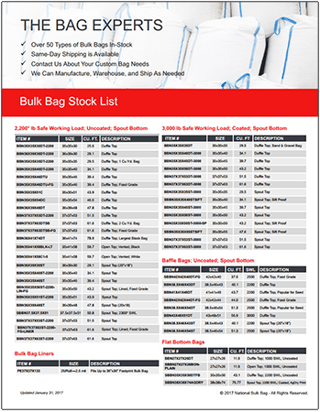There’s quite a bit of confusion encompassing food grade bulk bags. There are so many regulatory bodies and entities that offer guidelines on food packaging that it’s hard to keep track of! There’s AIB (American Institute of Baking), FDA (Food and Drug Administration), HACCP (Hazard Analysis Critical Control Point), ISO 22000 (International Organization for Standardization) BRC (British Retail Consortium) and, the latest and greatest, GFSI (Global Food Safety Initiative).
Navigating all these rules and regulations is difficult, so let’s examine these regulatory bodies and sort out what is most important to you.
For regular updates, subscribe to our blog by filling out the “Subscribe to our blog updates” form to the right.
Why so many regulatory bodies and rules for food grade bulk bags?
Although there are a ton of regulatory bodies, rules and regulations surrounding food grade bulk bags, let’s not forget that they all have the same goal: keeping food producers, food processors, and consumers safe. The CDC (Centers for Disease and Control) estimates that yearly, 1 out of ever 6 Americans will contract some form of food-borne illness. Of those, 3,000 people will die.
Of course, compared to other nations around the globe, western food regulations and corporate diligence play a large role in keeping food safe. Remember, regulation is meant to protect the consumer as well as the companies involved in the food supply chain. It doesn’t mean that regulatory bodies, rules and regulations can’t be more uniform and work better for the stakeholders in the food supply chain.
How do you know if your bulk packaging meets the current standards?
As all industries in the food supply chain, the bulk packaging industry needs to be stringent when it comes to food grade materials as many of the building blocks of food that we eat arrives in bags such as grains, legumes, flour, salt, sugar, protein, etc. To make it easier for businesses of all sizes, the global market is shifting towards GFSI (Global Food Safety Initiative) standardization. GFSI is an all-encompassing regulatory body governed by some of the biggest names in food such as Cargill, McDonald’s, Wal-Mart, Nestle and more.
GFSI's goals are to:
- Reduce food safety risks by delivering equivalence and convergence between effective food safety management systems.
- Manage cost in the global food system by eliminating redundancy and improving operational efficiency.
- Develop competencies and capacity building in food safety to create consistent and effective global food systems.
- Provide unique international stakeholder platform for collaboration, knowledge, exchange and networking.
Moving towards an all-encompassing initiative like GFSI makes a lot of sense. It will make the businesses involved in the food supply chain much more efficient in complying with the food safety best practices and regulations. Moving towards an all-encompassing initiative will also give the food industry a unified voice for best practices, new regulations and standards, and a place to find out if your bulk packaging meets the current standards.
Food safety is all about continuous analysis and improvement
Food safety should encompass material selection, manufacturing environments, packaging, storage, and transportation. Because of this, food safety is ever changing and is more important than ever to continue to educate and invest in yourself and your employees on new standards, regulations and best practices. Today, continuous improvement is an important cog in the food supply chain wheel and it is imperative to be part of your food safety initiatives. Having company policies and procedures that embraces continuous improvement and has sense of urgency surrounding food safety can be the difference between having a food safe environment or not.
Thanks for reading!
 Thanks for reading our quick guide to food grade bags! We hope you found our quick guide useful and informative.
Thanks for reading our quick guide to food grade bags! We hope you found our quick guide useful and informative.
Are you interested in purchasing food grade bulk bags? If so, you'll want to download our free buyer's guide to food grade bulk bags!
This guide will help you make the proper purchasing decision when considering food grade FIBCs. You'll learn about the standards, certifications, and specifications that make food grade bags unique.
Click the button below to download the Buyer's Guide to Food Grade Bulk Bags and learn everything you need to know before purchasing food grade FIBCs!






